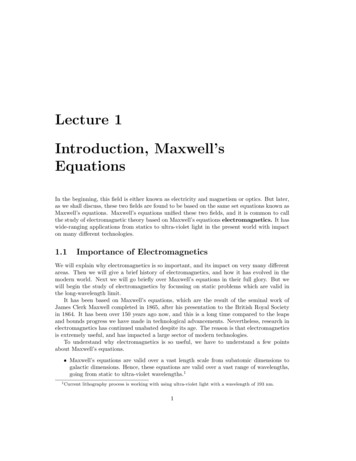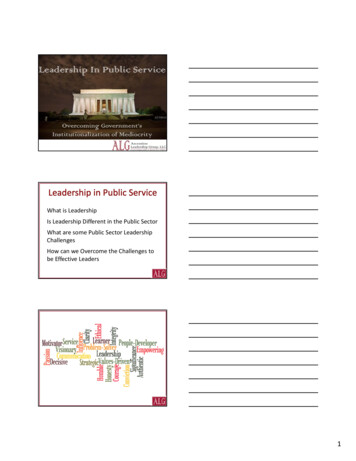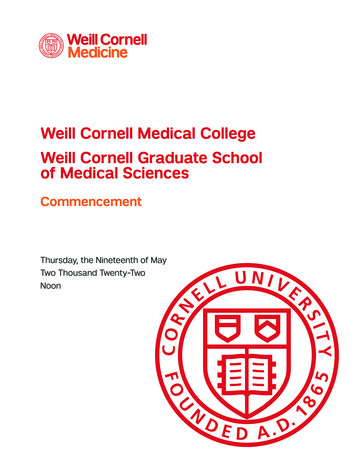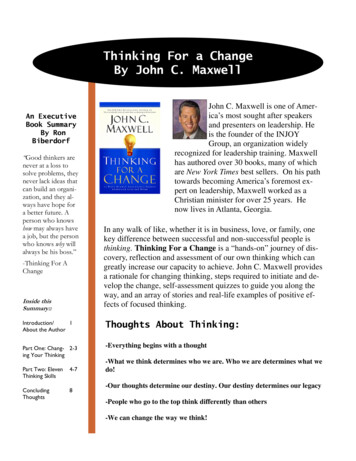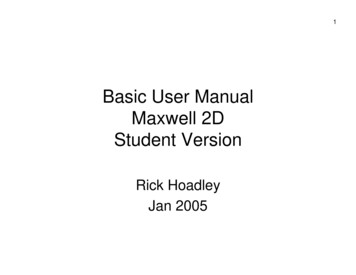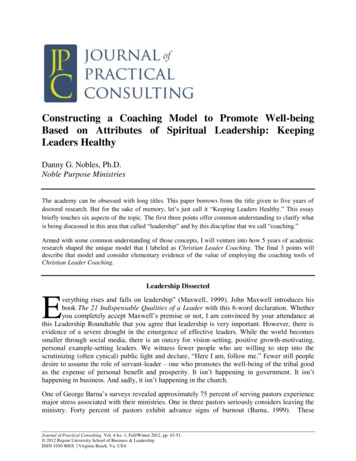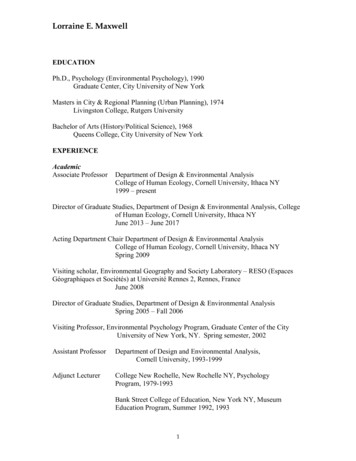
Transcription
Lorraine E. MaxwellEDUCATIONPh.D., Psychology (Environmental Psychology), 1990Graduate Center, City University of New YorkMasters in City & Regional Planning (Urban Planning), 1974Livingston College, Rutgers UniversityBachelor of Arts (History/Political Science), 1968Queens College, City University of New YorkEXPERIENCEAcademicAssociate ProfessorDepartment of Design & Environmental AnalysisCollege of Human Ecology, Cornell University, Ithaca NY1999 – presentDirector of Graduate Studies, Department of Design & Environmental Analysis, Collegeof Human Ecology, Cornell University, Ithaca NYJune 2013 – June 2017Acting Department Chair Department of Design & Environmental AnalysisCollege of Human Ecology, Cornell University, Ithaca NYSpring 2009Visiting scholar, Environmental Geography and Society Laboratory – RESO (EspacesGéographiques et Sociétés) at Université Rennes 2, Rennes, FranceJune 2008Director of Graduate Studies, Department of Design & Environmental AnalysisSpring 2005 – Fall 2006Visiting Professor, Environmental Psychology Program, Graduate Center of the CityUniversity of New York, NY. Spring semester, 2002Assistant ProfessorDepartment of Design and Environmental Analysis,Cornell University, 1993-1999Adjunct LecturerCollege New Rochelle, New Rochelle NY, PsychologyProgram, 1979-1993Bank Street College of Education, New York NY, MuseumEducation Program, Summer 1992, 19931
Lorraine E. MaxwellHunter College, City University of New York, New York NY,Psychology Department, Fall 1990Queens College, City University of New York, Flushing NY,Interior Design, Fall 1983City University of New York Alternative Degree Program,Research methods course, Fall 1979Essex County Community College, Newark NJ, UrbanStudies Program, 1973-1975Assistant Professor of Research, non-tenure track. Sociology DepartmentRutgers University, New Brunswick NJ, 1970-1972Research AssistantQueens College Institute of Community Studies, FlushingNY, 1968-1969PlanningProject Manager, Associate, Gruzen Samton, Architects Planners Interior Designers,New York, NY, 1977-1993Senior Planner, Mayor's Policy & Development Office, City Planning OfficeNewark NJ, 1972-1977Education Planner, New Jersey State Department of Education, Trenton NJ1969-1970PUBLICATIONSA. JournalsMaxwell, L.E. & Cassells, R.C. In review. Adolescents’ experience of theirneighborhood: Safety, affordances and stigma. Children, Youth and Environments.Maxwell, L. E. (2019). Book review: Practice-based research in children’s play. W.Russell, S. Lester, & H. Smith. Children, Youth and Environments, 29, 164-166.Maxwell, L.E. & French, R. (2016). Elementary school library design: Studentperceptions of a Learning Commons. Children, Youth and Environments, 26, 61-82.Maxwell, L.E. (2016). School building quality, school social climate and academicachievement: A mediation model. Journal of Environmental Psychology, 46, 206-216.doi.:10.1016/j.jenvp.2016.04.0092
Lorraine E. MaxwellMaxwell, L. E. (2015). Book review: The Science of Play: How to build playgrounds thatenhance children’s development. Susan G. Solomon. Children, Youth and Environments,25, 301-303.Maxwell, L. E. & Schechtman, S. (2012). The role of objective and perceived schoolbuilding quality in student academic outcomes and self-perception. Children, Youth andEnvironments, 22, 24-51.Whipple, S. Evans, G.W., Barry, R.L., Maxwell, L.E. (2010). An ecological perspectiveon cumulative school and neighborhood risk factors related to academic achievement.Journal of Applied Developmental Psychology, 31, 422-427.Jang, S-O. & Maxwell, L.E. (2009). A cross-cultural study of the types of children’s playand attention time between Korea and USA for planning activity area of day care centers.Journal of the Architectural Institute of Korea: Planning and Design, May, 51-58.Maxwell, L.E., Mitchell, M.R., & Evans, G.W. (2008). Effects of play equipment andloose parts on preschool children’s outdoor play behavior: An observational study anddesign intervention. Children, Youth and Environments, 18 (2), 37-63.Travlou, P., Eubanks Owens, P., Ward Thompson, C., & Maxwell, L. (2008). Placemapping with teenagers: Locating their territories and documenting their experience ofthe public realm. Children’s Geographies, 6(3), 309-326.Maxwell, L.E. & Chmielewski, E. J. (2008). Environmental personalization andelementary school children’s self-esteem. Journal of Environmental Psychology, 28, 143153.Maxwell, L.E. (2007). Competency in child care settings: The role of the physicalenvironment. Environment and Behavior, 39(2), 229-245.Laquatra, J., Maxwell. L.E. & Pierce, M. (2005). Indoor air pollutants: Limited-resourcehouseholds and childcare facilities. Journal of Environmental Health, 67(7), 39-43.Shin, J., Maxwell, L.E., & Eshelman, P. (2004). Hospital birthing room design: A studyof mother’s perception of hominess. Journal of Interior Design, 30(2) 23-26.Maxwell, L.E. (2003). Home and school density effects on elementary school children:The role of spatial density. Environment and Behavior, 35 (4), 566-578.Miller, A. S. & Maxwell, L.E. (2003). Exploring the role of home design in fosteringfamily interaction: The use of programming methods in research. Journal of InteriorDesign, 29 (1&2), 50-65.Maxwell, L. E. & Evans, G.W. (2002). Museums as learning settings: The importance ofthe physical environment. Journal of Museum Education, 27(1), 3-7.3
Lorraine E. MaxwellMaxwell, L. E. & Killeen, J. P. (2002). Museum visits: Experiences of special educationand typically developing children. Journal of Museum Education, 27(1), 18-21.Maxwell, L. E. (2002). Children’s healthcare environments: A book review. Journal ofArchitectural and Planning Research, 19 (2), 176-178.Maxwell, L. E. (2000). A safe and welcoming school: What students, teachers, andparents think. Journal of Architectural and Planning Research, 17(4), 271-282.Maxwell, L. E. & Evans, G. W. (2000). The effects of noise on pre-school children’s prereading skills. Journal of Environmental Psychology, 20, 91-97.Evans, G. W., Maxwell, L. E., & Hart B. (1999). Parental language and verbalresponsiveness to children in crowded homes. Developmental Psychology, 35 (4), 10201023.Maxwell, L. E. (1999). Children, computers, and school furniture. The EducationalFacility Planner, 35(2), 5-7.Maxwell, L. E. (1999). Long term effects of crowding on children. Bulletin of PeopleEnvironment Studies, 13, Summer, 12-13.Laeser, K. L., Maxwell, L. E., & Hedge, A. (1998). The effect of computer workstationdesign on student posture. The Journal of Research on Computing in Education, Winter,31 (2), 173-188.Evans, G. W. & Maxwell, L. E., (1997). Chronic noise exposure and reading deficits: Themediating effects of language acquisition. Environment and Behavior, 29(5), 638-656.Maxwell, L. E., (1996). Multiple effects of home and day care crowding. Environmentand Behavior, 28(4), 494-511.Maxwell, L. E. (1996). Designing early childhood education environments: A partnershipbetween architect and educator. The Educational Facility Planner, 33 (4), 14-18.B. Book chaptersMaxwell, L. E. (2018). The role of the physical environment in education. In A. Devlin(Ed.). Environmental psychology and human well-being: Effects of built and naturalsettings (pp.135-165). San Diego, CA. Elsevier.Ferguson, K. T. & Maxwell, L. E. (2016). Setting influences on child development. InThe Encyclopedia of Contemporary Child Development. Thousand Oaks, CA: Sage.4
Lorraine E. MaxwellMaxwell, L. E. & Evans, G.W. (2014). Children and the physical environment. In R.Cooper, E. Burton & C. L. Cooper (Eds.) Wellbeing: A complete reference guide, VolumeII, Wellbeing and the Environment (pp. 273-300). Oxford, UK: Wiley-Blackwell.Maxwell, L.E. (2009). Chaos outside the home: The school environment (pp.83-96). InG.W. Evans & T. D. Wachs (Eds.), Chaos and its influence on children’s development:An ecological perspective. Washington, DC: American Psychological Association.Maxwell, L.E. (2007). Preschool and day care environments. In R. Lueder & V. Rice(Eds.), Child Ergonomics (pp. 653-688). New York: Taylor and Francis.Maxwell, L.E. (2006). Crowding, class size, and school size. In H. Frumkin, R. Geller, I.L. Rubin, & J. Nodvin (Eds.), Safe and Healthy School Environments (pp. 13-19).Oxford, UK: Oxford University Press.Maxwell, L.E. (2006). Noise. In H. Frumkin, R. Geller, I.L. Rubin, & J. Nodvin (Eds.),Safe and Healthy School Environments (pp. 34-45). Oxford, UK: Oxford UniversityPress.Evans, G.W. & Maxwell, L.E. (2004). Noise and human behavior. In N. Stanton, A.Hedge, K. Brookhuis, E. Salas, & H. Hendrick (Eds.) Handbook of human factors andergonomics methods (pp. 72.1-72.5). New York: CRC Press.C. ProceedingsSimon, N.S., Evans, G.W., & Maxwell, L.E. (2006). Building quality, academicachievement and the achievement gap. XIIth Architecture & BehaviorColloqiuium. Monte Verita, Switzerland.Maxwell, L. E. & Evans, G. W. (1998). Interior noise exposure and reading readinessamong preschool children. In Carter, N. L. Eden, D. & Brown, A. L., (Eds.), 7thInternational Congress on Noise as a Public Health Problem. Sydney, Australia.Maxwell, L. E. (1996). A safe and welcoming school: A community research project. InApplied Research in Architecture and Planning, Architectural Research CentersConsortium, Tucson, AZ: Arizona State University, pp. 21-29.Maxwell, L. E., (1985). A case study: Staff/administration participation in site locationand spatial planning for a correctional facility. In S. Klein, R. Wener, & S. Lehman(eds.), EDRA 16 proceedings, Environmental change/Social change (pp. 359-360). NewYork, NYD. MonographsMaxwell, L.E. (1999). School building renovation and student performance. Phoenix,AZ.: Council of Educational Facility Planners, International.5
Lorraine E. MaxwellE. NewslettersMaxwell, L. E. (2009). ‘Big house, better house’ is so 2007: It doesn’t take a McMansionto have the perfect space for family interaction. Christian Science Monitor,www.csmonitor.comMaxwell, L. E. (2009). Cornell Perspectives: It doesn’t take a McMansion to have theperfect space for family interaction. Cornell Chronicle Online. www.news.cornell.eduMaxwell, L. E. & Evans, G. W. (2008). Community-based child care settings.Implications, 6(1). http://www.informedesign.umn.edu/ news/jan v06r-p.pdfMaxwell, L.E. (2001). Does you school’s design foster student learning? Space perstudent may be important. On Board. N. Y. State School Boards Association, 2(21), 7.Maxwell, L. E. (1999). Assessing your childcare space. Family Childcare Connections, 9(1). 1-2.Maxwell, L. E. (1997). Designing preschool classrooms for inclusive programs. ChildCare Center Connections, 6 (3), 2-3.F. Fact sheets and brochuresMaxwell, L. E., (1995). The physical environment of a childcare center: What parentsshould know. Ithaca, NY: Cornell University, A Cornell Cooperative Extensionpublication.Maxwell, L. E., (1996). Facility planning and management overview. Facility Planningand Management Notes, 1(1). Cornell Cooperative Extension, Cornell University, Ithaca,NYMaxwell, L. E. & Hedge, A. (1996). Carpet and indoor air quality. Facility Planning andManagement Notes, 1(2), Cornell Cooperative Extension, Cornell University, Ithaca, NYMaxwell, L. E. & Becker, F. (1996). The workplace of the 21st century. FacilityPlanning and Management Notes, 1(3), Cornell Cooperative Extension, CornellUniversity, Ithaca, NY.Maxwell, L. E. (1996). Preventing Carpal Tunnel Syndrome in Computer Users. FacilityPlanning and Management Notes, 1(4), Cornell Cooperative Extension.Maxwell, L. E. & Hedge, A. (1997). Lighting in the Workplace. Facility Planning andManagement Notes, 1(5), Cornell Cooperative Extension.Maxwell, L. E., (1997). Cleaning Preserves Carpets and Protects our Health. FacilityPlanning and Management Notes, 1(6), Cornell Cooperative Extension.6
Lorraine E. MaxwellMaxwell, L. E. (1997). Employer-Sponsored Childcare. Facility Planning andManagement Notes. 1(7), Cornell Cooperative Extension.Maxwell, L. E. (1998). Designing the Home Office. Facility Planning and ManagementNotes, 1(8). Cornell Cooperative Extension.Maxwell, L. E., Healthy Mouse Use. (1998). Facility Planning and Management Notes,1(9), Cornell Cooperative Extension.LaQuatra, J. & Maxwell, L. E. (2000). Radon in the Schools. Facility Planning andManagement Notes, 1 (10). Cornell Cooperative Extension.Maxwell, L. E. & Kase, L. I. (1997). Design of Long-term care facilities for Alzheimer'spatients. A Cornell Cooperative Extension Publication.Maxwell, L. E., Noise in the Workplace (2000). Facility Planning and ManagementNotes, 1(11), Cornell Cooperative Extension.G. Training ManualsMaxwell, L. E. (1998). Designing child care settings: A child centered approach. Ithaca,NY: Cornell Cooperative Extension.Maxwell, L. E. (1999). Parents' and Children's Activities Book. Ithaca, NY: CornellCooperative Extension.H. VideosMaxwell, L. E., (1998). A safe and efficient workplace: Alternative workplace strategies.Ithaca, NY: International Workplace Studies Program, Cornell UniversityMaxwell, L. E., (1998). A safe and efficient workplace: Ergonomic issues. Ithaca, NY:International Workplace Studies Program, Cornell University.CORNELL COURSES TAUGHTDEA 6200 Graduate Seminar - Studies in Human Environment RelationsDEA 3590/6500 Problem Seeking through ProgrammingDEA 4100 Diversity and Facility DesignDEA 4150 Strategic Facility Planning for Social InstitutionsHE 3100 Human Ecology Mentoring ProgramDEA 7100 Graduate Pro Seminar7
Lorraine E. MaxwellGRADUATE STUDENT THESESStephanie M. Lev, 1996, Facilities, Planning and Management, The effects ofplants on patient anxiety levels in a university health center waiting room, ChairKathryn L. Laser, 1997, Human Environment Relations, The effect of computerworkstation design on student posture and computer task performance: Children grades 6and 8, ChairChristy Martin, 2001, Facilities Planning and Management, Nursing Homedesign: The effect of environmental quality and design on visitation rates, ChairAllison Miller, 2001, Human Environment Relations, Fostering family interactionthrough home design: An application of the architectural programming process, ChairKimberly Michaels, 2001, Landscape Architecture, Consider the child: Designinga garden playscape for infants and toddlers, Committee memberJung-hye Shin, 2001, Human Environment Relations, Effect of birthing roomdesign features on mothers’ perception of homeyness, ChairEmily Kuperstein, 2002, Human Environment Relations, The impact of increasedenvironmental personalization on the socio-emotional development of kindergartenersand first graders, ChairLesa Carter, 2002, PhD, Education, Experiences of black women students ingraduate education, Committee memberMari R. Mitchell, 2003, Human-Environment Relations, Increasing dramatic playfor preschool children in an outdoor play environment, ChairEsther S. Greenhouse, 2003, Human Environment Relations, The impact ofimproved lighting on minimizing environmental press associated with the visual deficitsof Alzheimer’s disease, ChairMalcolm A, Brown, 2003, Facilities Planning and Management, Going for thegreen: A case study analysis evaluating energy performance of a conventional vs. greenOlympic speed skating oval, Committee memberCaroline Hegarty, 2004, Facilities, Planning and Management, Effects of floorplan on layout on social network formation in college residence halls ChairSusan Porter Wyche, 2004, Human Environment Relations, Designing speculativecleaning products: Using elders’ past and present cleaning experiences to inform design,ChairLinda Jang, Human Environment Relations, 2005, The effects of the physicalenvironment of residential group care facilities on children's social competence, ChairNicole Simon, 2005, Human Environment Relations, Building quality, academicachievement and self-competency in New York City public schools, ChairMelissa Darmente, Interior Design, 2005, Universal design and personalization inplay manipulatives for children, Committee member.Jung Ja Park, 2006, Human Environment Relations, Case study: Child CareCenter Design for Parent-Child Interaction, ChairNicole Sroka, 2006, Human Environment Relations, Meta-Analysis of publishedliterature on the role of loose parts in the play behavior of non-typically developingchildren, ChairBeth Johnson, 2006, City and Regional Planning, The role of the black church incommunity development, Committee member.8
Lorraine E. MaxwellJamie E. Holmer, 2007, Human Environment Relations, Exploring effectiveeducation of family childcare providers about issues related to indoor environmentalpollutants, ChairTammy Johnson, 2010, Facilities Planning and Management, Cornell child carecenter outdoor playscapes: A post-occupancy evaluation, ChairVanessa P. Del Aguila, 2010, Human Environment Relations, The effect ofclassroom searing arrangement on the social competency of autistic preschoolers, ChairSuzanne Schechtman, 2011, Human Environment Relations, The impact ofstudents’ perception of school building quality and self-perception on academicoutcomes, ChairRaechel Schneider, 2013, Facilities, Planning and Management, The impact ofspatial design on teacher communications: A case study, ChairKarlton Lattimore, 2013, Human Environment Relations, The effect of seatingorientation and spatial boundaries on person-centered counseling sessions, ChairDanielle Dunn, 2014, City and Regional Planning, Principles for communityengagement in the process of school design, Minor Committee memberAsea Thompson, 2015, City and Regional Planning, It’s not just art. MinorCommittee member.Jacqueline Callan, 2018, Facilities, Planning and Management. An underutilizedtool: The physical classroom environments impacts student collaborative work, Chair.KEYNOTE PRESENTATIONSSchool building quality and engaging students in learning. Northeast Regional Meeting,CEFPI. Saratoga Springs, NY, April 2015.The school of the future: Why facility design matters. New York Chapter of CEFPI(Council of Educational Facility Planners, International), Troy, NY, November 2013.Why is the physical environment of childcare environments important? Annual meetingof the Day Care and Child Development Council of Tompkins County. Ithaca, NY, May,2001.A place for children. Child Caregivers' Workshop Day, Steuben County Regional HumanDevelopment Program Cornell Cooperative Extension, Wayland-Cohocton School, NY.April, 1998.The physical environment of infant-toddler child care programs. Early Head StartConference, Head Start Region IIA. Newark, NJ. October, 1996.The importance of the physical environment for children's development. Jefferson-LewisChild Care Council 4th Annual Child Care Conference. Watertown, NY. April, 1995.INVITED LECTURES, TALKS9
Lorraine E. MaxwellPresentation in celebration of 50th anniversary of the Environmental Psychology Programof the City University of New York. May, 2018.Role of research in design. Graduate design class. College of Design, North CarolinaState University. Raleigh, NC. March, 2018.Methods in environmental psychology. Graduate class. College of Design, NorthCarolina State University. Raleigh, NC. March, 2015Youth self-perception and the physical environment. Youth Development ResearchUpdate, Bronfenbrenner Center for Translational Research, Ithaca, NY, June 2014School planning and design workshop. McGraw Ashley Architects, Syracuse, NY. June2011.How community noise affects children and adults. Rochester Soundscape Society, Inc. ACommunity Forum, June 6, 2009, Rochester, NY.Children, Teens, Place and Self-perception. Journée Internationale, IUFM (InstitutUniversitaire de Formation des Maîtres), June 2008. Rennes, France.Healthy learning environments. National School Supply and Equipment Associationannual conference. March 2006, Orlando, FL.Importance of the physical environment in child care programs. Mid York Child CareCoordinating Council, March 2005, Oneida County, New YorkHealthy learning environments. National School Supply and Equipment AssociationJanuary 2005. San Antonio, TXPanel topic, “Do school facilities affect academic outcomes”. California Coalition forAdequate School Housing annual conference. March 2005. Sacramento, CA.Designing for competency in early childhood environments. Child & Family StudiesSocial Sciences Interdisciplinary Program, State University of New York at Stony Brook,February, 2002.American Institute of Architects, New York Southern Tier chapter. March 2000.Kyoritsu Women's University, Tokyo, Japan. Graduate Program in Design. April 1999.Texas A & M University, College of Architecture. 1999 Rowlett lecture/EducationalFacilities Symposium. February 1999.St. James Presbyterian Church, New York City, NY. Youth Day Program, Spring 199710
Lorraine E. MaxwellManhattan Community College, City University of New York, New York, NY. EarlyChildhood Education Program. Fall, 1994CONFERENCE PRESENTATIONSConsidering client needs in Corrections: Incorporating social and physical concerns inchange. Environmental Design Research Association, New York, NY. June 1985.An instrument for observing children's use of outdoor play equipment. AmericanPsychological Association, Annual meeting, New York, NY. August, 1995.A safe and welcoming school: A community research project. Architectural ResearchCenter's Consortium. University of Arizona, School of Architecture. Tucson. AZ. April,1996.Preschool children's use of space in inclusive programs and effects on task involvement.Inclusive Schools and Communities for Children and Youth, University of the State ofNew York and the State Department of Education. Tarrytown, NY. May, 1996.A method for training child care providers to design child care spaces. A panelpresentation: Research and the design of children's and youth environments.Environmental Design Research Association, Annual meeting, Salt Lake City, UT. June,1996.Shared spaces for children: Inclusive classroom settings. Environmental Design ResearchAssociation. Montreal, Canada. May, 1997.Computer Workstation Design Effects on Posture and Performance: Children Grades 6 &8. The 41st Annual Conference for the Human Factors and Ergonomics Society 'Ancient Wisdom, Future Technologies'. September, 1997.Preschool children's use of outdoor play equipment. Environmental Design ResearchAssociation. St. Louis, MO. March, 1998.Teaching child care providers to design childcare spaces. Teaching environmentalpsychology workshop. Environmental Design Research Association. St. Louis, MO.March, 1998.The effect of noise on preschool children's pre reading skills. The InternationalAssociation for People-Environment Studies, Eindhoven, the Netherlands. July, 1998.An instrument for evaluation children's outdoor play. A symposium on evaluatingchildren's environments. The International Association for People-Environment Studies,Eindhoven, the Netherlands. July, 1998.11
Lorraine E. MaxwellThe effects of home and school crowding on elementary school children's reading skills.Environmental Design Research Association, Orlando, FL. June, 1999.The role of play equipment design on preschool children's play behavior in an outdoorsetting. The International Association for People-Environment Studies. Paris, France,July 2000.Museum physical characteristics and effects on children's retention of information: Acase study. The International Association for People-Environment Studies. Paris, France,July 2000.Children, Computers and Classrooms. International Ergonomics Society/Human Factorsand Ergonomics Society. San Diego, CA. August, 2000.Indoor Air Quality in Early Childhood Facilities, Northeast Region Conference, Councilof Educational Facilities Planner International. Lancaster, PA. April, 2001.Educational Ergonomics in the 21st Century. 15th International Occupational Ergonomicsand Safety Conference, Fairfax, VA. June, 2001.Environmental effects on preschool children’s development of competency.Environmental Design Research Association, Edinburgh, Scotland. July, 2001.Research issues on noise and child development. Environmental Design ResearchAssociation, Edinburgh, Scotland. July, 2001.Home design and family interaction: A programming process. Environmental DesignResearch Association, Philadelphia, PA. May, 2002Spaces for family interaction: A child’s perspective. Environmental Design ResearchAssociation, Philadelphia, PA. May, 2002Children’s environmental meaning and self-concept. International Association forPeople- Environment Studies, La Coruna, Spain. July, 2002.Preschool children’s competency and the design of the childcare spaces: A classroomrating scale. International Association for People - Environment Studies (IAPS), LaCoruna, Spain. July, 2002.Teens and Public Spaces, Environmental Design Research Association, MilwaukeeWisconsin, May 2003Children’s Residential Spaces, Environmental Design Research Association, MilwaukeeWisconsin, May 200312
Lorraine E. MaxwellThe role of home and community in shaping children’s self concept, The CommunityDevelopment Society, Ithaca, NY, July 2003Designing schools: What do children think is important? KnowledgeWorks FoundationConference on School Facilities, Columbus, Ohio, May 2004The role of playground design in children’s dramatic and constructive play behavior,Environmental Design Research Association, Albuquerque, New Mexico, June 2004The role of noise and density in school health, American School Health Association,Pittsburgh, PA, October 2004The role of public spaces in adolescents’ sense of self and identity. EDRA, April 2005.Vancouver, BCSocial network formation and college residence hall design. Co-authors, CarolineHegarty & Gary Evans. EDRA, April 2005. Vancouver, BCEffects of perceptions of school building quality on self-competency and academicachievement among fourth graders in New York City public schools. Nicole Simon,Lorraine Maxwell, & Gary Evans. EDRA, April 2005. Vancouver, BCUsing environment-behavior research to inform parent education and early childhoodcaregivers' training programs. EDRA (Environmental Design Research Association),May 2006, Atlanta, GA.Children's exposure to risk factors in multiple settings: The case for an ecologicalexamination of children's lives. ICAP (International Congress of Applied Psychology),July 2006, Athens, Greece.Simon, N.S., Evans, G.W., & Maxwell, L.E. (2006). Building quality, academicachievement and the achievement gap. XIIth architecture & behavior colloquium. MonteVerita, Switzerland. March.Designing for Diversity. Tompkins County Diversity Consortium and the Society forHuman Resource Management of Tompkins County, Diversity Community Round tableat Tompkins County Diversity Consortium and the Society for Human ResourceManagement of Tompkins County, Diversity Community Roundtable. May 31, 2007.Assessing the physical environment's role in children's learning and health. Collaborativeon Health and the Environment's Learning and Development Disabilities Initiative.Morehouse School of Medicine, Atlanta GA. November 2007.School building quality, student perception of quality, academic achievement, and socioemotional development. American Educational Research Association, Chicago, Ill., April2007.13
Lorraine E. MaxwellThe micro-system: Chaos outside the home – school. First Annual BronfenbrennerConference: Chaos and Children's Development: Levels of Analysis and Mechanisms.Cornell University, October, 2007.Adolescents and the use of public space. Association of American Geographers, Boston,MA. April, 2008.Adolescent perception of neighborhood quality in a French and US city. EnvironmentalDesign Research Association, Kansas City, MO. June, 2009.Race, class and cultural issues among the elderly in the United States. CornellConference on Aging and the Environment, Ithaca, NY. July, 2009.Children’s perception of learning spaces. Council of Educational Facility Planners, N.E.Annual Conference, Philadelphia, PA. May 2010.Adolescent perceptions of self and school building quality. Environmental DesignResearch Association, Washington, D.C. June 2010.Whipple, S., Evans, GW, Barry, R., Maxwell, LE. An ecological perspective oncumulative risk and school-wide academic achievement. Society for the Research inChild Development (SRCD). Montreal, Canada. March, 2011.Adolescent perception: School building quality and self-perception. EnvironmentalDesign Research Association (EDRA). Chicago, IL. June, 2011.Design of childcare spaces for competency. National Association for the Education ofYoung Children (NAEYC). Orlando, FL. November, 2011.School building quality and users’ perception of educational adequacy. Council ofEducational Facility Planners, N.E. Annual Conference. New York, NY May 2012.Student perception of school building quality. IAPS 22 (International Association ofPeople-Environment Studies). Glasgow, Scotland, June, 2012.School building quality, school social environment and student academic achievement.Environmental Design Research Association (EDRA). Providence, RI. May, 2013.School design and student achievement. Environmental Design Research Association(EDRA), New Orleans, LA, May, 2014.School Building Condition, student attendance, and social climate: A mediation model.Society for Research on Child Development (SRCD), Philadelphia, PA., March, 2015.Participant in invited conference: Advancing the measurement of social and behavioraldeterminants toxic stress in young children. Center for the Developing Child, HarvardUniversity, Boston, MA. July, 2015.14
Lorraine E. MaxwellHow adolescents perceive and use their home, school and neighborhood. EnvironmentalDesign Research Association (EDRA), Raleigh, NC. May, 2016.The role of home, school and neighborhood environments: The ability to achieve privacy,reflect on one’s life and gain independence. Jean Piaget Society, Chicago, IL. June 2016.Rochelle C. Cassells, Lorraine E. Maxwell, and Aastha Wadwa.Influence of the physical environment on ad
Hunter College, City University of New York, New York NY, Psychology Department, Fall 1990 Queens College, City University of New York, Flushing NY, Interior Design, Fall 1983 City University of New York Alternative Degree Program, Research methods course, Fall 1979 Essex County Community College, Newark NJ, Urban Studies Program, 1973-1975



